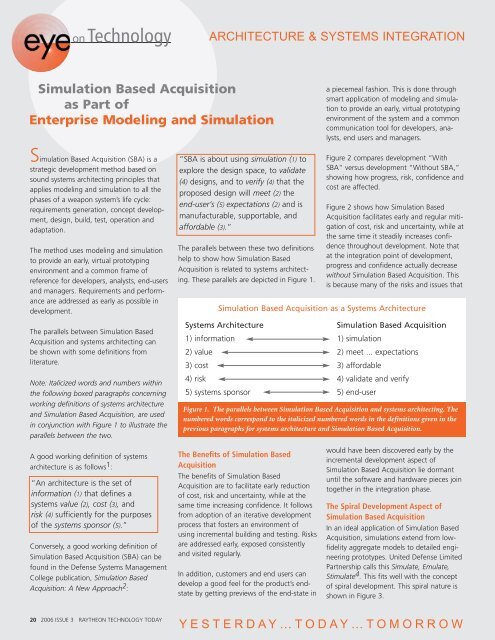Technology Today 2006 Issue 3 - Raytheon
Technology Today 2006 Issue 3 - Raytheon
Technology Today 2006 Issue 3 - Raytheon
Create successful ePaper yourself
Turn your PDF publications into a flip-book with our unique Google optimized e-Paper software.
on<strong>Technology</strong><br />
Simulation Based Acquisition<br />
as Part of<br />
Enterprise Modeling and Simulation<br />
Simulation Based Acquisition (SBA) is a<br />
strategic development method based on<br />
sound systems architecting principles that<br />
applies modeling and simulation to all the<br />
phases of a weapon system’s life cycle:<br />
requirements generation, concept development,<br />
design, build, test, operation and<br />
adaptation.<br />
The method uses modeling and simulation<br />
to provide an early, virtual prototyping<br />
environment and a common frame of<br />
reference for developers, analysts, end-users<br />
and managers. Requirements and performance<br />
are addressed as early as possible in<br />
development.<br />
The parallels between Simulation Based<br />
Acquisition and systems architecting can<br />
be shown with some definitions from<br />
literature.<br />
Note: Italicized words and numbers within<br />
the following boxed paragraphs concerning<br />
working definitions of systems architecture<br />
and Simulation Based Acquisition, are used<br />
in conjunction with Figure 1 to illustrate the<br />
parallels between the two.<br />
A good working definition of systems<br />
architecture is as follows 1 :<br />
“An architecture is the set of<br />
information (1) that defines a<br />
systems value (2), cost (3), and<br />
risk (4) sufficiently for the purposes<br />
of the systems sponsor (5).”<br />
Conversely, a good working definition of<br />
Simulation Based Acquisition (SBA) can be<br />
found in the Defense Systems Management<br />
College publication, Simulation Based<br />
Acquisition: A New Approach 2 :<br />
20 <strong>2006</strong> ISSUE 3 RAYTHEON TECHNOLOGY TODAY<br />
ARCHITECTURE & SYSTEMS INTEGRATION<br />
“SBA is about using simulation (1) to<br />
explore the design space, to validate<br />
(4) designs, and to verify (4) that the<br />
proposed design will meet (2) the<br />
end-user’s (5) expectations (2) and is<br />
manufacturable, supportable, and<br />
affordable (3).”<br />
The parallels between these two definitions<br />
help to show how Simulation Based<br />
Acquisition is related to systems architecting.<br />
These parallels are depicted in Figure 1.<br />
Systems Architecture<br />
1) information<br />
2) value<br />
3) cost<br />
4) risk<br />
5) systems sponsor<br />
The Benefits of Simulation Based<br />
Acquisition<br />
The benefits of Simulation Based<br />
Acquisition are to facilitate early reduction<br />
of cost, risk and uncertainty, while at the<br />
same time increasing confidence. It follows<br />
from adoption of an iterative development<br />
process that fosters an environment of<br />
using incremental building and testing. Risks<br />
are addressed early, exposed consistently<br />
and visited regularly.<br />
In addition, customers and end users can<br />
develop a good feel for the product’s endstate<br />
by getting previews of the end-state in<br />
a piecemeal fashion. This is done through<br />
smart application of modeling and simulation<br />
to provide an early, virtual prototyping<br />
environment of the system and a common<br />
communication tool for developers, analysts,<br />
end users and managers.<br />
Figure 2 compares development “With<br />
SBA” versus development “Without SBA,”<br />
showing how progress, risk, confidence and<br />
cost are affected.<br />
Figure 2 shows how Simulation Based<br />
Acquisition facilitates early and regular mitigation<br />
of cost, risk and uncertainty, while at<br />
the same time it steadily increases confidence<br />
throughout development. Note that<br />
at the integration point of development,<br />
progress and confidence actually decrease<br />
without Simulation Based Acquisition. This<br />
is because many of the risks and issues that<br />
Simulation Based Acquisition as a Systems Architecture<br />
Simulation Based Acquisition<br />
1) simulation<br />
2) meet ... expectations<br />
3) affordable<br />
4) validate and verify<br />
5) end-user<br />
Figure 1. The parallels between Simulation Based Acquisition and systems architecting. The<br />
numbered words correspond to the italicized numbered words in the definitions given in the<br />
previous paragraphs for systems architecture and Simulation Based Acquisition.<br />
would have been discovered early by the<br />
incremental development aspect of<br />
Simulation Based Acquisition lie dormant<br />
until the software and hardware pieces join<br />
together in the integration phase.<br />
The Spiral Development Aspect of<br />
Simulation Based Acquisition<br />
In an ideal application of Simulation Based<br />
Acquisition, simulations extend from lowfidelity<br />
aggregate models to detailed engineering<br />
prototypes. United Defense Limited<br />
Partnership calls this Simulate, Emulate,<br />
Stimulate4 . This fits well with the concept<br />
of spiral development. This spiral nature is<br />
shown in Figure 3.<br />
YESTERDAY…TODAY…TOMORROW

















